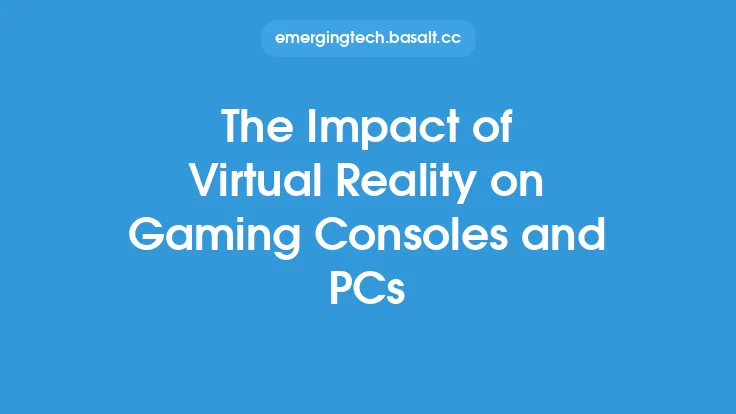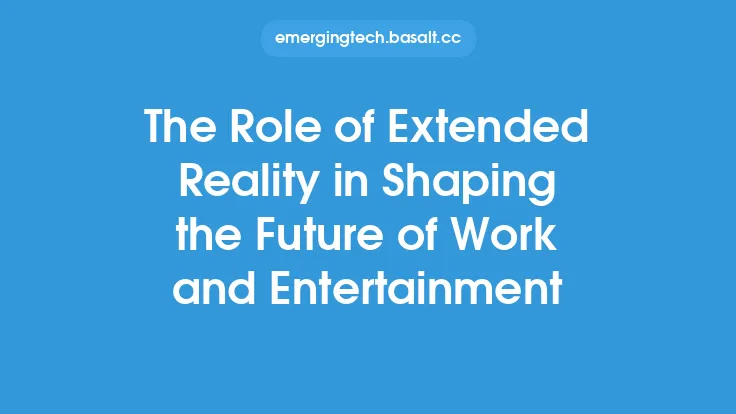The concept of Extended Reality (XR) has been gaining significant attention in recent years, and its impact on business and society is becoming increasingly evident. XR encompasses a range of technologies, including Virtual Reality (VR), Augmented Reality (AR), and Mixed Reality (MR), which are transforming the way we interact with information, each other, and the world around us. As XR continues to evolve and improve, it is essential to understand its potential applications, benefits, and challenges, as well as its far-reaching implications for various industries and aspects of our lives.
Introduction to Extended Reality Technologies
Extended Reality technologies are designed to enhance or extend human experience by providing immersive, interactive, and engaging environments. VR, for instance, creates a completely artificial environment, shutting out the physical world, while AR overlays digital information onto the real world, enhancing it. MR, on the other hand, combines elements of both VR and AR, allowing for the interaction of virtual objects with real-world objects. These technologies are made possible by advancements in fields such as computer vision, machine learning, and display technologies. Understanding the technical underpinnings of XR is crucial for appreciating its potential applications and limitations.
Impact on Business
The impact of Extended Reality on business is multifaceted. One of the most significant areas of influence is in training and education. XR technologies can provide immersive, interactive training experiences that simulate real-world scenarios, making them particularly effective for industries that require hands-on training, such as healthcare, aviation, and manufacturing. This not only enhances the learning experience but also reduces the costs associated with traditional training methods, such as travel and equipment. Furthermore, XR can improve customer engagement through innovative marketing strategies, such as virtual product demonstrations and immersive brand experiences. Retailers, for example, can use AR to allow customers to see how products would look in their homes before making a purchase, enhancing the shopping experience and potentially increasing sales.
Impact on Society
The societal impact of Extended Reality is equally profound. In the field of education, XR can make learning more accessible and engaging, especially for subjects that are traditionally difficult to teach, such as complex scientific concepts or historical events. XR can also play a critical role in healthcare, beyond just training. For instance, VR can be used for therapy, helping patients overcome phobias or anxieties in a controlled environment. Additionally, AR can assist in surgical procedures by providing surgeons with real-time data and 3D visualizations, potentially leading to more precise and less invasive operations. In terms of social interaction, XR can enable new forms of remote communication that feel more natural and immersive, potentially reducing the sense of isolation associated with remote work or social distancing.
Technical Challenges and Limitations
Despite the promising applications of Extended Reality, there are several technical challenges and limitations that need to be addressed. One of the primary concerns is the cost of XR equipment, which can be prohibitively expensive for many individuals and businesses. Furthermore, the development of high-quality XR content requires significant expertise and resources, which can be a barrier to entry for many potential adopters. Additionally, there are issues related to user experience, such as motion sickness in VR and the need for more sophisticated AR glasses that are both functional and aesthetically pleasing. From a technical standpoint, advancements in areas like eye-tracking, hand-tracking, and light field displays are necessary to create more immersive and interactive XR environments.
Ethical and Privacy Concerns
As Extended Reality becomes more integrated into our daily lives, ethical and privacy concerns are emerging. One of the key issues is data privacy, as XR devices can collect a vast amount of personal data, including biometric information and user behavior. There is a need for clear regulations and guidelines on how this data is collected, stored, and used. Additionally, there are concerns about the potential for XR to be used in ways that are manipulative or deceptive, such as in advertising or political campaigns. Ensuring transparency and accountability in XR applications is crucial to maintaining trust and preventing misuse. Furthermore, the impact of XR on mental health, particularly in terms of addiction and social isolation, needs to be carefully considered and studied.
Future Directions and Opportunities
Looking ahead, the future of Extended Reality is filled with opportunities and challenges. As the technology continues to evolve, we can expect to see more sophisticated and affordable XR devices, as well as a wider range of applications across various industries. The integration of XR with other emerging technologies, such as artificial intelligence (AI) and the Internet of Things (IoT), could lead to even more innovative and transformative experiences. For instance, AI-powered XR could enable more personalized and adaptive learning experiences, while XR integrated with IoT could create smart environments that are more interactive and responsive to user needs. However, realizing these opportunities will require ongoing investment in research and development, as well as collaboration between technologists, policymakers, and societal stakeholders to ensure that XR is developed and used in ways that are beneficial and responsible.
Conclusion
In conclusion, Extended Reality is poised to have a profound impact on both business and society, offering a wide range of applications and benefits that can transform industries and improve lives. However, to fully realize the potential of XR, it is essential to address the technical, ethical, and privacy challenges associated with these technologies. By doing so, we can ensure that XR develops in a way that is sustainable, equitable, and beneficial for all. As we move forward in this exciting and rapidly evolving field, it is crucial to maintain a focus on the evergreen aspects of XR, including its core technologies, applications, and societal implications, to provide a foundation for ongoing innovation and progress.





